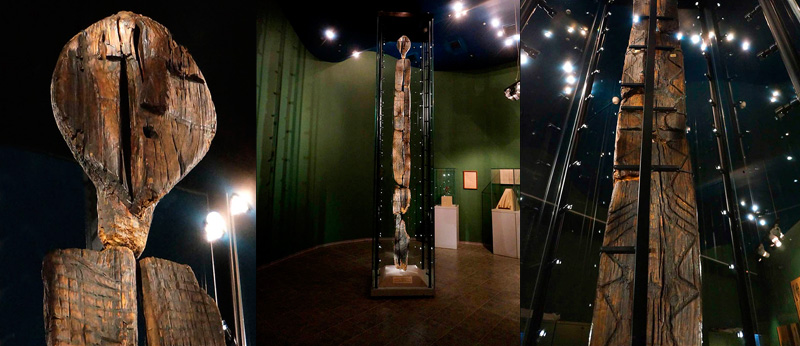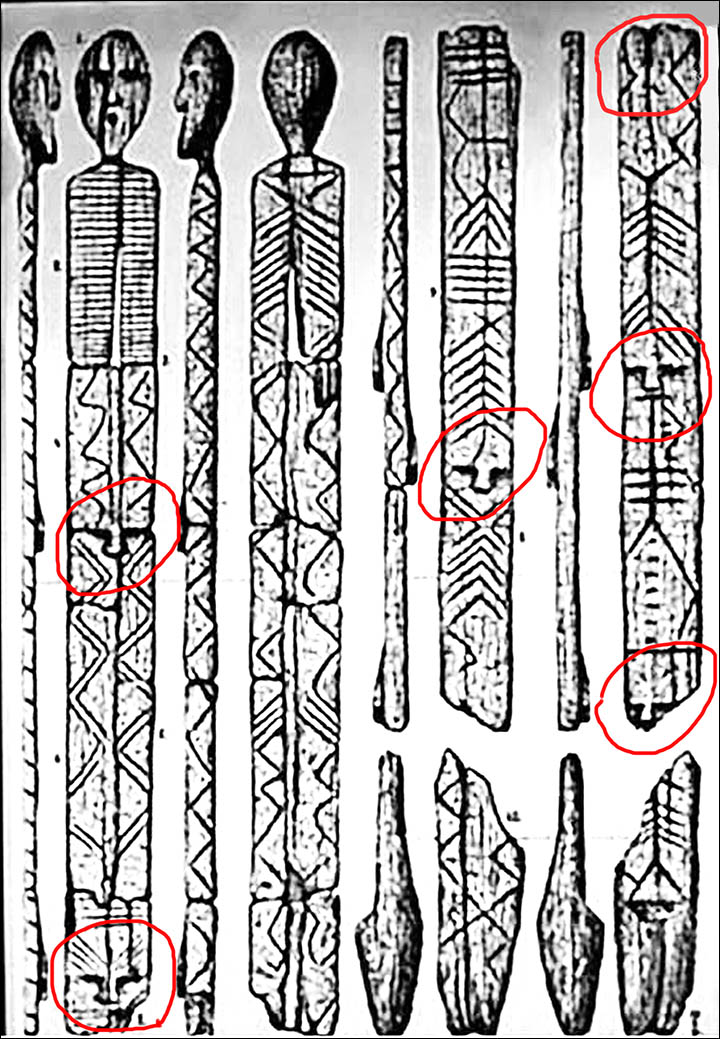It looks like you're using an Ad Blocker.
Please white-list or disable AboveTopSecret.com in your ad-blocking tool.
Thank you.
Some features of ATS will be disabled while you continue to use an ad-blocker.
share:
The Shigir Idol was discovered in 1894 at a dig in the Shigir peat bog near Kirovgrad, in the Ural
Mountains approximately 100 km from Russia's 4th largest city, Yekaterinburg. It was found at a
depth of 4m and as with other finds in peat bogs, such as the bog people, the preservation of the
idol is due to low temperature, highly acidic water and a lack of exposure to oxygen.
The idol was made from a 159 year-old larch which has been carbon dated in separate analyses to about 9,500 ya, making it the oldest wooden statue known. It was extracted from the bog in pieces and unfortunately, several of these pieces were later lost in the chaos of war and revolution and can now only be seen in drawings made by archaeologist Vladimir Tolmachev. The original reconstruction made by Professor Dmitry I. Lobanov used only the largest fragments and stood 2.8m high. Estimates put the original height at about 5.3m (just shy of 17 and a half feet). What remains today is on display in inert gas-filled display case at the Yekaterinburg History Museum.
The mysteries surrounding this statue are many: Who made it? What did it look like in its original form? What was it made for and what do the markings on its surface mean? From The Siberian Times (via Obsuragator) :

The horizontal lines are thought to represent ribs but as with all of the markings, it's really anyone's guess. In addition to the lines, the idol also contains six faces:

Map? Historical record? Creation story? Simple decoration? At this point all theories are more or less equally valid. The design elements and the location of the find on the western edge of Siberia lead me to wonder if the Shigir Idol is possibly a primitive cousin/forerunner of the North American totem poles.
The idol was made from a 159 year-old larch which has been carbon dated in separate analyses to about 9,500 ya, making it the oldest wooden statue known. It was extracted from the bog in pieces and unfortunately, several of these pieces were later lost in the chaos of war and revolution and can now only be seen in drawings made by archaeologist Vladimir Tolmachev. The original reconstruction made by Professor Dmitry I. Lobanov used only the largest fragments and stood 2.8m high. Estimates put the original height at about 5.3m (just shy of 17 and a half feet). What remains today is on display in inert gas-filled display case at the Yekaterinburg History Museum.
The mysteries surrounding this statue are many: Who made it? What did it look like in its original form? What was it made for and what do the markings on its surface mean? From The Siberian Times (via Obsuragator) :

'It is obvious that the elements of geometrical ornament had some meaning,' stated Savchenko and Zhilin in explaining the Idol's ancient markings.
'The difficulty of interpretation is the polysemy symbolism of these symbols' - in other words, the possible multiple related meanings. According to ethnography, a straight line could denote land, or horizon - the boundary between earth and sky, water and sky, or the borderline between the worlds.
'A wavy line or zigzag symbolised the watery element, snake, lizard, or determined a certain border. In addition, the zigzag signaled danger, like a pike. Cross, rhombus, square, circle depicted the fire or the sun, and so on.'
Savchenko and other museum staff have postulated that among its purposes was that of an early map, or navigator. Straight lines, wave lines and arrows indicated ways of getting to the destination and the number of days for a journey, with waves meaning water path, straight lines meaning ravines, and arrows meaning hills, according to this theory which has yet to be fully researched.
The horizontal lines are thought to represent ribs but as with all of the markings, it's really anyone's guess. In addition to the lines, the idol also contains six faces:

Author Petr Zolin, citing scientific work by Savchenko and Zhilin, stated: 'The characters of Idol cannot have an unambiguous interpretation. If these are images of spirits that inhabited the human world in ancient times, the vertical position of figures (one above the other) probably relate to their hierarchy.
'Placing images on the front and back planes of the Idol, possibly indicate that they belong to different worlds. If there are depicted myths about the origin of humans and the world, the vertical arrangement of the images may reflect the sequence of events. Ornaments can be special signs which mark something as significant.'
The Idol reflects what these people looked like, with straight noses and high cheekbones.
Map? Historical record? Creation story? Simple decoration? At this point all theories are more or less equally valid. The design elements and the location of the find on the western edge of Siberia lead me to wonder if the Shigir Idol is possibly a primitive cousin/forerunner of the North American totem poles.
edit on 2014-10-22 by theantediluvian because: (no
reason given)
While reading your post I was thinking the same as you in that it may have been a for runner to the totem . a reply to:
theantediluvian
Wow, talk about trying to read into it more than needs to be there...
The 'geometric' markings look simply like that - decorations. Maybe someone got bored, or just wanted to try their hand at making a village sign marker, something along the lines of 'this way to the woodcarver's neighborhood' or something.
And a lot of the 'faces' look instead like penises - something any self-respecting wood carver has been proud to include in their human depictions for quite a while now.
That said, it's a wonderful find.
The 'geometric' markings look simply like that - decorations. Maybe someone got bored, or just wanted to try their hand at making a village sign marker, something along the lines of 'this way to the woodcarver's neighborhood' or something.
And a lot of the 'faces' look instead like penises - something any self-respecting wood carver has been proud to include in their human depictions for quite a while now.
That said, it's a wonderful find.
That face sure got around back in the day. There are other threads here I can link later.
originally posted by: nukedog
That face sure got around back in the day. There are other threads here I can link later.
When you're wood carver isn't up to 'world class' artistic standards you go for the basic model.
Very interesting find. Totems were probably very popular in many cultures but in almost all other cases all that is left of them is a post hole shadow. Something very common at most sites.
a reply to: theantediluvian
Maybe it was a sex doll, a sentry like the Terra cotta warriors from China? Maybe it was a statue of somebodies loved one that passed, a grave marker.
Maybe it was a God…nah, scratch that one.
Maybe it was a sex doll, a sentry like the Terra cotta warriors from China? Maybe it was a statue of somebodies loved one that passed, a grave marker.
Maybe it was a God…nah, scratch that one.
originally posted by: intrptr
a reply to: theantediluvian
Maybe it was a sex doll, a sentry like the Terra cotta warriors from China? Maybe it was a statue of somebodies loved one that passed, a grave marker.
Maybe it was a God…nah, scratch that one.
or maybe....

Maybe it was a calendar.
If you count the "faces", taking the faces/penises separators ( circled in red on the picture ) into account, you get 12 different spaces. Too lazy to count the rests of the markings to see if it would fit with days... lol
...
If you count the "faces", taking the faces/penises separators ( circled in red on the picture ) into account, you get 12 different spaces. Too lazy to count the rests of the markings to see if it would fit with days... lol
...
a reply to: Hanslune
Not to derail my own thread, but did you see the news about the wooden Greek statue found in the well?
If you're looking for well preserved wooden artifacts, anaerobic environments are where it's at!
Not to derail my own thread, but did you see the news about the wooden Greek statue found in the well?
If you're looking for well preserved wooden artifacts, anaerobic environments are where it's at!
originally posted by: Hanslune
originally posted by: nukedog
That face sure got around back in the day. There are other threads here I can link later.
When you're wood carver isn't up to 'world class' artistic standards you go for the basic model.
.
True. The resemblance is uncanny to me though. You're probably correct in that reasoning though.
a reply to: theantediluvian
Beautiful, seven faces huh?
Reminds me of totem pole.
Perhaps it had some similar meaning and purpose
en.wikipedia.org...
I'm thinking it may not be an Idol at all
Beautiful, seven faces huh?
Reminds me of totem pole.
Perhaps it had some similar meaning and purpose
en.wikipedia.org...
The meanings of the designs on totem poles are as varied as the cultures that make them. Totem poles may recount familiar legends, clan lineages, or notable events. Some poles celebrate cultural beliefs while others are mostly artistic. Certain types of totem poles are part of mortuary structures, and incorporate grave boxes with carved supporting poles, or recessed backs for grave boxes. Poles illustrate stories that commemorate historic persons, represent shamanic powers, or provide objects of public ridicule.
"Some of the figures on the poles constitute symbolic reminders of quarrels, murders, debts, and other unpleasant occurrences about which the Native Americans prefer to remain silent... The most widely known tales, like those of the exploits of Raven and of Kats who married the bear woman, are familiar to almost every native of the area. Carvings which symbolize these tales are sufficiently conventionalized to be readily recognizable even by persons whose lineage did not recount them as their own legendary history." (Reed 2003).
House front poles were meant to show the success of the families.
Totem poles were never objects of worship. Very early European explorers thought they were worshipped, but later explorers such as Jean-François de La Pérouse noted that totem poles were never treated reverently; they seemed only occasionally to generate allusions or illustrate stories, and were usually left to rot in place when people abandoned a village. The association with "idol worship" was an idea from local Christian missionaries of the nineteenth century, who considered their association with Shamanism as an occult practice.
I'm thinking it may not be an Idol at all
edit on 123131p://bWednesday2014 by Stormdancer777 because: (no reason given)
a reply to: theantediluvian
OhNo… its Aleeeens, for sure.
Maybe its just a sort of rough attempt at a canoe, bridge board, scaffolding or "flag". Or their version of a Posturepedic. Here, you can lay in the swamp or you can lie on this… bunk board.
maybe they tied naughty town folk to it and pelted them with dead frogs?
Need to be more original than just another religious relic anymore.
OhNo… its Aleeeens, for sure.
Maybe its just a sort of rough attempt at a canoe, bridge board, scaffolding or "flag". Or their version of a Posturepedic. Here, you can lay in the swamp or you can lie on this… bunk board.
maybe they tied naughty town folk to it and pelted them with dead frogs?
Need to be more original than just another religious relic anymore.
Its a Totem Pole.
Maybe complete ignorance on my part but I am only really aware of native americans being prolific totem builders. Are there many other cultures known for constructing them?.
A quick look in the internet search engine of my choice brings me to the wikipedia article Totem pole attributes this solely to native americans.
Maybe complete ignorance on my part but I am only really aware of native americans being prolific totem builders. Are there many other cultures known for constructing them?.
A quick look in the internet search engine of my choice brings me to the wikipedia article Totem pole attributes this solely to native americans.
That face...I've seen it somewhere before...

...seriously though, if this were meant to depict a normal human the artist really missed the mark.

...seriously though, if this were meant to depict a normal human the artist really missed the mark.
originally posted by: signalfire
And a lot of the 'faces' look instead like penises - something any self-respecting wood carver has been proud to include in their human depictions for quite a while now.
That said, it's a wonderful find.
Just what I was going to say...
a reply to: Dabrazzo
No not solely N.A., scroll down to bottom of wiki article
No not solely N.A., scroll down to bottom of wiki article
Similar structures Poles similar to totem poles are also found elsewhere in the world. Due to their similarities to totem poles, they are often described as being totem poles.[citation needed] Notable cultures with such example of having a totem pole-like objects are those by indigenous people of Jilin, northeast China; the Koreans; and the Māori, indigenous people of New Zealand. The Ainu of Japan have created totem-poles with Ainu motifs since admiring the traditions from Indigenous people of North America. Mundha is a one-piece decorative wooden pillar carved by a Madia Gond bridegroom in India after he is engaged. It is kept in front of the community dormitory (ghotul) during his marriage ceremony. The Madia Gond are residents of Bhamragad Taluka, of Gadchiroli District, of Maharashtra, India.[16] See also Crest (heraldry) Huabiao Stele Irminsul Tiki
originally posted by: intrptr
a reply to: theantediluvian
Maybe it was a sex doll, a sentry like the Terra cotta warriors from China? Maybe it was a statue of somebodies loved one that passed, a grave marker.
Maybe it was a God…nah, scratch that one.
Toothpick?
a reply to: theantediluvian
It sort of has a face reminiscent of The Grey's...
What it really reminds me of is a totem pole, an early version.
It sort of has a face reminiscent of The Grey's...
What it really reminds me of is a totem pole, an early version.
new topics
-
Big Storms
Fragile Earth: 25 minutes ago -
Where should Trump hold his next rally
2024 Elections: 3 hours ago -
Shocking Number of Voters are Open to Committing Election Fraud
US Political Madness: 3 hours ago -
Gov Kristi Noem Shot and Killed "Less Than Worthless Dog" and a 'Smelly Goat
2024 Elections: 4 hours ago -
Falkville Robot-Man
Aliens and UFOs: 4 hours ago -
James O’Keefe: I have evidence that exposes the CIA, and it’s on camera.
Whistle Blowers and Leaked Documents: 5 hours ago -
Australian PM says the quiet part out loud - "free speech is a threat to democratic dicourse"...?!
New World Order: 6 hours ago -
Ireland VS Globalists
Social Issues and Civil Unrest: 6 hours ago -
Biden "Happy To Debate Trump"
2024 Elections: 7 hours ago -
RAAF airbase in Roswell, New Mexico is on fire
Aliens and UFOs: 7 hours ago
top topics
-
A Warning to America: 25 Ways the US is Being Destroyed
New World Order: 17 hours ago, 21 flags -
Blast from the past: ATS Review Podcast, 2006: With All Three Amigos
Member PODcasts: 9 hours ago, 13 flags -
James O’Keefe: I have evidence that exposes the CIA, and it’s on camera.
Whistle Blowers and Leaked Documents: 5 hours ago, 12 flags -
Biden "Happy To Debate Trump"
2024 Elections: 7 hours ago, 12 flags -
Australian PM says the quiet part out loud - "free speech is a threat to democratic dicourse"...?!
New World Order: 6 hours ago, 12 flags -
Mike Pinder The Moody Blues R.I.P.
Music: 9 hours ago, 8 flags -
What is the white pill?
Philosophy and Metaphysics: 9 hours ago, 6 flags -
Shocking Number of Voters are Open to Committing Election Fraud
US Political Madness: 3 hours ago, 5 flags -
Ireland VS Globalists
Social Issues and Civil Unrest: 6 hours ago, 5 flags -
RAAF airbase in Roswell, New Mexico is on fire
Aliens and UFOs: 7 hours ago, 5 flags
active topics
-
Big Storms
Fragile Earth • 4 • : marg6043 -
"We're All Hamas" Heard at Columbia University Protests
Social Issues and Civil Unrest • 290 • : TheWoker -
Post A Funny (T&C Friendly) Pic Part IV: The LOL awakens!
General Chit Chat • 7137 • : PorkChop96 -
Massachusetts Drag Queen Leads Young Kids in Free Palestine Chant
Social Issues and Civil Unrest • 21 • : ToneD -
Biden "Happy To Debate Trump"
2024 Elections • 49 • : TheMisguidedAngel -
Candidate TRUMP Now Has Crazy Judge JUAN MERCHAN After Him - The Stormy Daniels Hush-Money Case.
Political Conspiracies • 816 • : xuenchen -
Where should Trump hold his next rally
2024 Elections • 13 • : Edumakated -
Shocking Number of Voters are Open to Committing Election Fraud
US Political Madness • 6 • : marg6043 -
University of Texas Instantly Shuts Down Anti Israel Protests
Education and Media • 312 • : marg6043 -
Gov Kristi Noem Shot and Killed "Less Than Worthless Dog" and a 'Smelly Goat
2024 Elections • 30 • : TheMisguidedAngel
